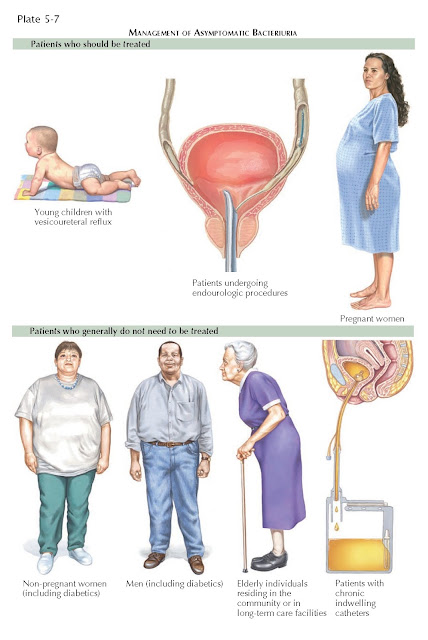BACTERIURIA
Bacteriuria is
defined as the presence of bacteria in uncontaminated urine. Bacteriuria can be
associated with a symptomatic urinary tract infection or can simply reflect
asymptomatic colonization. In the latter case, the significance and management
depends on the patient population.
The presence of bacteria in urine can be established
based on positive nitrite dipstick or culture. A clinically relevant degree of
bacteriuria is defined as the growth of more than 105 colony forming units (CFUs) of bacteria per milliliter on
urine culture. The presence of white blood cells in the urine, as indicated by
either positive leukocyte esterase on dipstick or direct visualization on
microscopy, suggests infection rather than mere colonization.
The prevalence of asymptomatic bacteriuria among
young, nonpregnant women is 1% to 3%. The prevalence is higher among pregnant
women, elderly patients, residents of long-term care facilities, and patients
with conditions requiring frequent self-catheterization or chronic indwelling
urinary catheters. Bacteriuria is much less common in men (< 0.1%) but increases
with age, likely because of prostatic disease and consequent urinary retention.
MANAGEMENT
The appropriate management of asymptomatic bacteriuria
depends on patient characteristics.
In young children, asymptomatic bacteriuria in the
setting of vesicoureteral reflux can lead to renal scarring and even failure.
Thus patients with known reflux (see Plate 2-21) are often maintained on
antibiotic prophylaxis until the reflux spontaneously improves or a definitive
surgical intervention is performed. In healthy children without known reflux,
general screening for or treatment of bacteriuria is not recommended.
In pregnant women, asymptomatic bacteriuria increases
the risk of pyelonephritis, likely because of relaxation of smooth muscle
around the ureters. As such, treatment of asymptomatic bacteriuria has been
shown to decrease the likelihood of pyelonephritis from 20%-35% to less than
4%. Moreover, treatment lowers the probability of preterm labor and low birth
weight. The current recommendation is to screen pregnant women by performing a
urine culture around week 16 of gestation. The optimal frequency of screening
is not known. If necessary, antimicrobial therapy should be instituted for 3 to
7 days.
In patients scheduled to undergo endourologic
procedures that may injure the urinary mucosal, screening and treatment of
bacteriuria is recommended. If necessary, treatment should begin just before
the procedure. Treatment does not need to continue postoperatively unless a catheter is to remain in place.
In nonpregnant women, asymptomatic bacteriuria
increases the risk of cystitis, but neither general screening nor treatment is
recommended because bacteriuria tends to rapidly recur. Likewise, there is no
benefit to general screening or treatment of asymptomatic bacteriuria in men. In
diabetic patients, treating asymptomatic bacteriuria has not been shown to
decrease or delay future urinary tract infections.
Similarly, in elderly individuals residing in
long-term care facilities, the treatment of asymptomatic bacteriuria has failed
to show benefits. In patients with chronic indwelling catheters, research
comparing treatment with a placebo has shown no difference in infection rates
and demonstrated higher rates of antibiotic resistance among patients receiving treatment.





